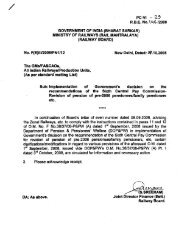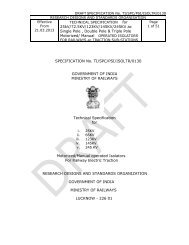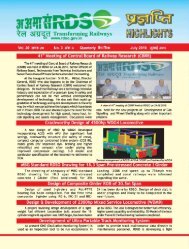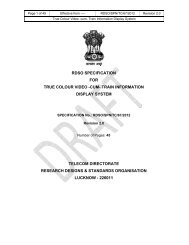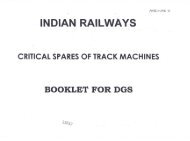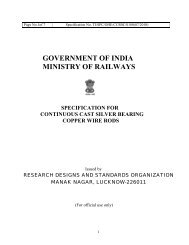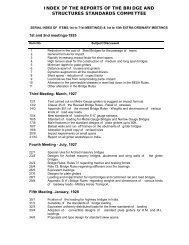SPECICATION NO. ETI/PSI/144 (12/91) SPECIFICATION FOR ... - rdso
SPECICATION NO. ETI/PSI/144 (12/91) SPECIFICATION FOR ... - rdso
SPECICATION NO. ETI/PSI/144 (12/91) SPECIFICATION FOR ... - rdso
You also want an ePaper? Increase the reach of your titles
YUMPU automatically turns print PDFs into web optimized ePapers that Google loves.
phases of the 220 or 132kV, three phase, effectively earthed transmission net work of the<br />
State Electricity Board, in case of a single phase transformer or in case of two single<br />
phase V-connected transformers/Scott connected transformer respectively. The Scottconnected<br />
transformer and V-connected single phase transformers are effective in<br />
reducing the voltage imbalance caused by the traction loads on the transmission net-work<br />
of the Electricity Board.<br />
One outer wide terminal of the secondary windings of traction transformer is<br />
connected to the catenary, the other outer side terminal being connected to the feeder.<br />
Two inner side terminals are, via series capacitors or directly, connected to each other,<br />
and their joint is solidly earthed and connected to the running rails.<br />
The load current from the sub-station flows through the catenary and returns to the<br />
sub-station through the feeder. Between two adjacent ATs, the load current fed from the<br />
catenary to the locomotive flows in the rail and is boosted up to the feeder through the<br />
neutral tape of the two ATs.<br />
Mid-way between two sub-stations, a SP is introduced. At the point of<br />
TSS and SP, a dead zone known as neutral section is provided in the OHE to avoid wrong<br />
phase coupling. The power to the catenary and feeder on each side of the TSS is fed by<br />
one feeder circuit breakers, even if there exist two breakers for one side. The two<br />
breakers are used as a stand-by for each other. For maintenance work and keeping the<br />
voltage drop within limits, one or more SSPs are introduced between the TSS and SP. On<br />
a double track section, a SSP normally has four sectioning interruptors and one<br />
paralleling interruptor, and a SP has two paralleling interruptors and two bridging circuit<br />
breakers. In case of fault on the OHE, the corresponding feeder circuit breaker of the substation<br />
trips and isolates it.<br />
A figure showing the principles of AT feeding system and a typical power<br />
supply diagram showing this general feeding arrangement at a traction sub-station and<br />
sections of the OHE are given in the sketch at Appendix-I.<br />
4.2.1 Protection System at traction sub-station:<br />
transformers:<br />
Following relays are provided for the protection of traction sub-station<br />
(a) Differentials relay.<br />
(b) Over current relay on receiving side.<br />
(c) Earth fault relay on receiving side.<br />
(d) Instantaneous over-current relay on receiving side.<br />
(e) Phase failure relay (to detect malfunction of feeder circuit breaker).<br />
(f) Auxiliary relays for transformer faults i.e. Buchholz, excessive winding<br />
and oil temperature strip and alarm, pressure relief device trip and alarm<br />
and low oil level alarm.<br />
(g) Over-current relay on 2x25 kV side as back-up to feeder protective relays.<br />
4.2.2. Following relays are provided for the protection of OHE:<br />
(a) Distance relay (with a parallelogram protection characteristics)<br />
- 5 -



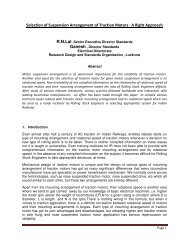

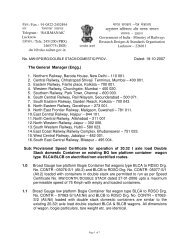
![Hkkjrljdkj] jsy ea= ky; vuql a/ kkuvfHkdYivkSj ekudlax Bu y ... - rdso](https://img.yumpu.com/21978459/1/184x260/hkkjrljdkj-jsy-ea-ky-vuql-a-kkuvfhkdyivksj-ekudlax-bu-y-rdso.jpg?quality=85)

